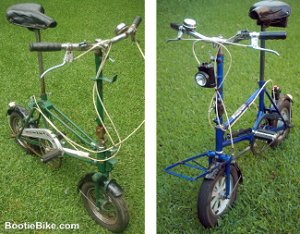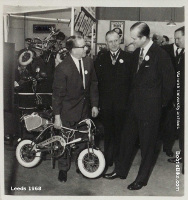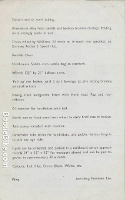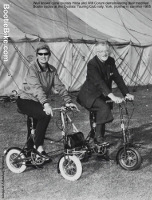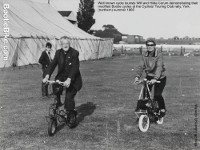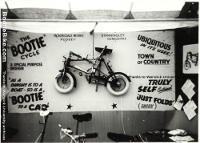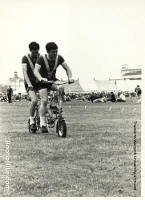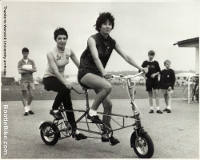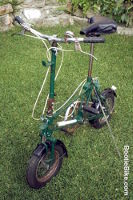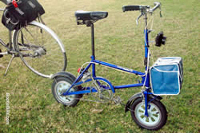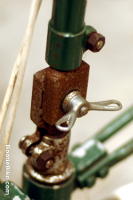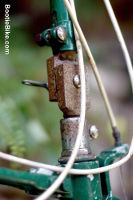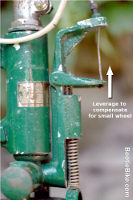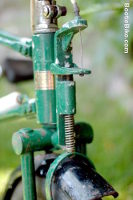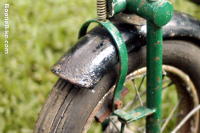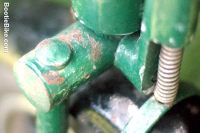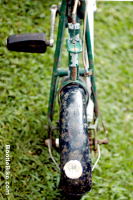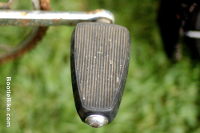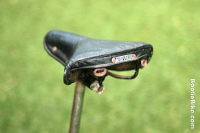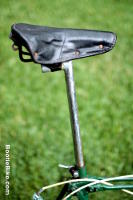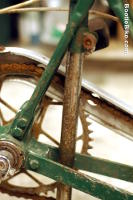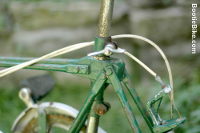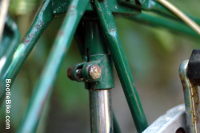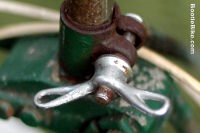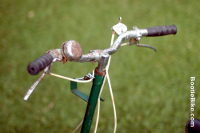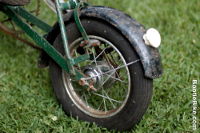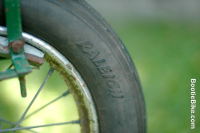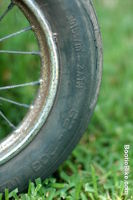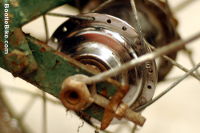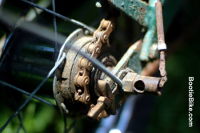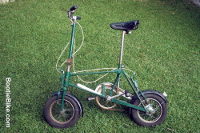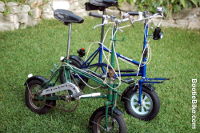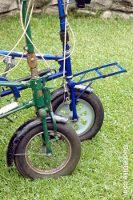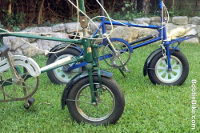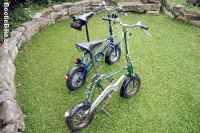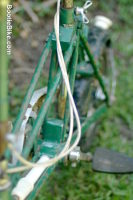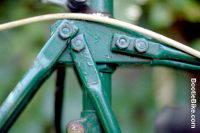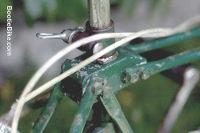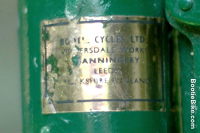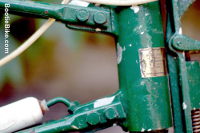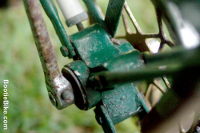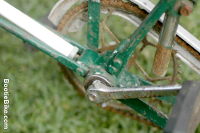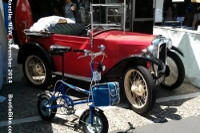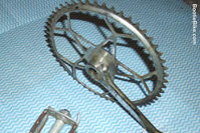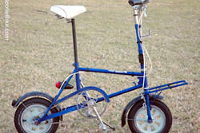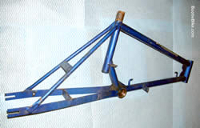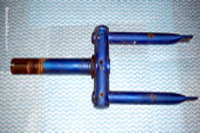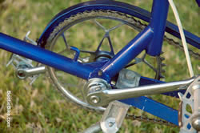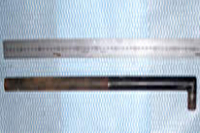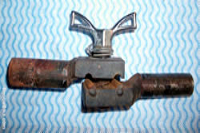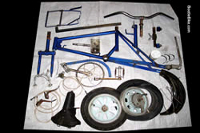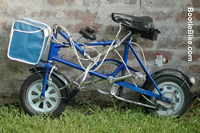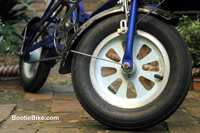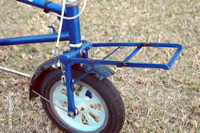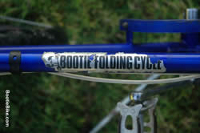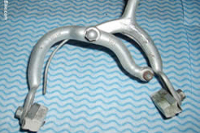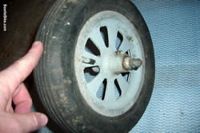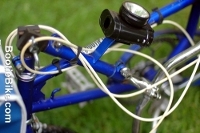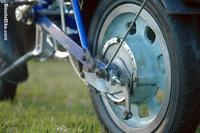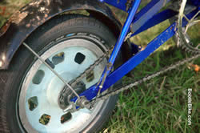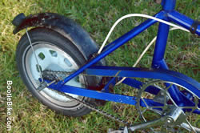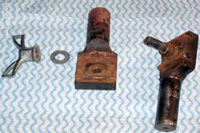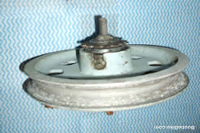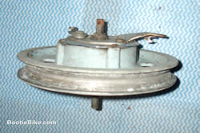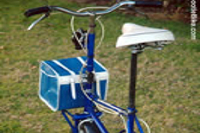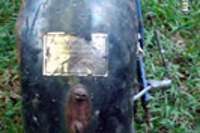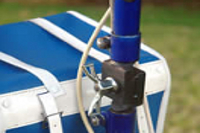1960s Bootie Folding Cycle
'As a dinghy is to a boat, so is the Bootie to a car'
The Bootie bicycle, or more properly, the 'Bootie Folding Cycle', is a small folding bicycle made in Stanningley, West Yorkshire, UK, from mid-1965 to early 1973. It's called a folding cycle, but it didn't really fold. What it did do was reintroduce the concept of the 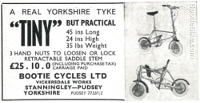 the very small bike with handlebars and seat post that tuck out of the way. This was pioneered by the French Le Petit Bi in the late 1930s and it has been followed in more recent times by any number of models, perhaps most notably the Daewoo Shuttle.
the very small bike with handlebars and seat post that tuck out of the way. This was pioneered by the French Le Petit Bi in the late 1930s and it has been followed in more recent times by any number of models, perhaps most notably the Daewoo Shuttle.
The re-emergence of this concept was perhaps inevitable in an era of both mini-things (mini cars, mini skirts, miniature radios) and an ascendant car culture. For the man (60s, remember) who had everything, why not a mini-cycle, one he could keep in the boot of the Wolseley? (Hence the name; yes, it's called the Bootie because you can keep it in the boot of your car. Were it North American it might have been called the Trunkie, or more likely the Trunkster.)
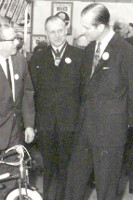 I have been told that the maker of the Bootie, F. T. Kitchin, was an innovative little firm willing to design and make whatever wasn't readily available, and I think their work with the Bootie supports that view. For example, they designed and made the hinges they needed to make the handlebars and seat tube fold out of the way, and the special brakes. However, I can't imagine such a small company envisioning anything approaching large scale production – rather I think they saw in the Bootie an opportunity to create a niche-market sideline to even out the peaks and troughs of their everyday trade.
I have been told that the maker of the Bootie, F. T. Kitchin, was an innovative little firm willing to design and make whatever wasn't readily available, and I think their work with the Bootie supports that view. For example, they designed and made the hinges they needed to make the handlebars and seat tube fold out of the way, and the special brakes. However, I can't imagine such a small company envisioning anything approaching large scale production – rather I think they saw in the Bootie an opportunity to create a niche-market sideline to even out the peaks and troughs of their everyday trade.
It evidently sold well enough for Kitchins to continue making it until 1973, but the bikes could never have been a common sight. Now, of course, the Bootie is a rarity, and it could have been forgotten had not Hadland and Pinkerton documented it in It's in the bag, their book on portable cycles. Some of the information here comes from that great little book.
Selling the Bootie
The Bootie was advertised regularly in the CTC magazine and promoted at shows (and it even had a viewing by the Duke of Edinburgh). The advertised price in the print ads (£25.10.0 in December 1966) included purchase tax and carriage. In promotional material is was described as a 'motoring accessory', a sort of last-mile bike to get one from a convenient parking space to the office.
The advertising made much of the fact that the folded bike was in a single, convenient piece. This was in contrast to the Moulton Stowaway, which split into two pieces to facilitate transport and storage. 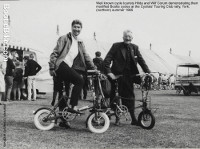 The Bootie didn't have to be 'taken to pieces to fold'. All one had to do was 'merely loosen three hand size wing nuts' and 'it can be carried in one hand like a suitcase.'
The Bootie didn't have to be 'taken to pieces to fold'. All one had to do was 'merely loosen three hand size wing nuts' and 'it can be carried in one hand like a suitcase.'
The Bootie was also touted as being useful for flat dwellers, caravanners, campers, boat owners and fishermen. A bike for all seasons? I don't think so, and least of all for touring. Nevertheless, well-known cycle tourists Wilf and Hilda Corum took a shine to the Bootie. Photos from the Cyclist's Touring Club (CTC) rally at York in 1965 show Wilf and Hilda proudly showing off their Booties, which had been lightened a tad by the fitment of Chater Lea chainsets and special handlebars and stems. The June/July 1966 issue of the CTC Cycletouring magazine carries a photo of Hilda, alongside her Bootie, with a local rustic at Cape Wrath, in the far north-west of the Scottish mainland.
And who would be the typical Bootie buyer? If you're a marketing expert you've probably got your own ideas by now, but perhaps the following first-hand account could be illuminating:
It was my Husband who purchased the bike at the Stoneleigh Park Agricultural Fair 1968 or 69. He loved gadgets and I allowed him to indulge himself, thinking that at least one of our six children would make use of it. He thought he would take it to the City (London) in the back of his car and then perhaps cycle to his office in the very heart of the City. Never did. I remember riding it in 1970 just a couple of miles to go to my Mother's house, in the last few hundred yards I went over the handlebars! The front wheel caught in a rut. I never tried it again.
Two generations of Bootie
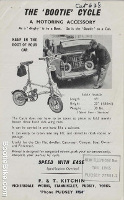 There were two 'generations' of Bootie bicycle. The first generation, released in mid-1965, had a frame made of pairs of half inch steel tubes. The flattened tube ends were bolted to chunky aluminium head, saddle and bottom bracket castings. The chainstays were of flat steel strip. Promotional material claimed the bike could be unbolted and packed in a carton approximately 24" x 15" x 15" (60cm x 38cm x 38cm), and reassembled in 30 minutes.
There were two 'generations' of Bootie bicycle. The first generation, released in mid-1965, had a frame made of pairs of half inch steel tubes. The flattened tube ends were bolted to chunky aluminium head, saddle and bottom bracket castings. The chainstays were of flat steel strip. Promotional material claimed the bike could be unbolted and packed in a carton approximately 24" x 15" x 15" (60cm x 38cm x 38cm), and reassembled in 30 minutes.
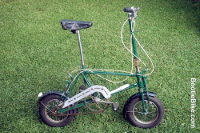
The wire wheels had wide, 20-hole chromed steel Westwood rims, the rear laced to half the holes of a 40-hole Sturmey Archer AW three speed hub. Each wheel was shod with a fat Raleigh-branded balloon tyre (203 x 62 ETRTO). Kitchins made their own brakes, of the stirrup type, cable operated, with a unique lever arrangement offering '3:1 leverage to give strong braking on small wheels'.
The handlebar stem was clamped to the upper part of a steel hinge fabricated from solid rectangular steel stock (the complete hinge weighing 700 grams). The lower hinge was clamped to the fork tube. Loosening a hand nut (of the kind then used on racing bikes) allowed the handlebars to be swung down over the side of the bike. Loosening another hand nut allowed the handlebars and stem to swivel around and fold flat against the frame. This method of folding the handlebars out of the way is now very common on folding bikes.
On the early Booties the seat tube was similarly hinged, so it too could be swung down against the side of the frame. However, within a year or so this arrangement was replaced by a very long, conventional seatpost that could be simply pushed down. It was located to the rear of the bottom bracket (rather than being directly above as in a conventional bike), so there was nothing to stop it from being lowered to its full extent. The green bike you see here (with a hub dated 6/66) is so equipped. The hinges and seatpost were chrome plated. A front-mounted luggage rack was available but not fitted to this example.
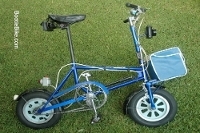
The second generation Bootie, believed to date from late-1968, had a frame that was somewhat more conventional. However, it was lugless (i.e. tubes just welded together), had a seat tube that ended mid-frame and still had strip steel chainstays instead of the tubes conventionally used. There was substantial gusseting at the join of the top, steer and downtubes and around the bottom bracket.
The wire wheels were replaced by single piece cast alloy units, shod with Michelin or Dunlop-branded tyres of the same size as the first generation bikes. The rear wheel was fitted with a built-in Sturmey Archer three speed gear and drum brake. It appears the hub flange on the drive side has been removed so it can be fitted to the wheel. The hinges and seatpost were painted black rather than chromed.
The front wheel of the second generation Bootie was fitted with a caliper brake, a GB alloy unit mounted on the rear of the forks. Disconcertingly, the right hand steering lock is limited by the brake cable and adjuster contacting the frame. There is plenty of lock available for riding, but it is very noticeable when manually manoeuvring the bike in a confined space. 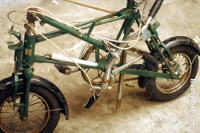 A more welcome feature is the use of cartridge bearings in the front wheel, something other bikes wouldn't have for decades.
A more welcome feature is the use of cartridge bearings in the front wheel, something other bikes wouldn't have for decades.
Don't let the alloy brake caliper and wheels lull you into thinking the Bootie is some sort of lightweight fun bike. I'm sure there were good reasons for specifying those parts in alloy, but I don't think saving weight was one of them. The second generation Bootie boasts nearly 17 kg of road-hugging weight, so the buyer got a lot for his/her money (the first generation model would be much the same if fitted with sidestand and front rack, and the very earliest, with folding seatpost, would have at least another half a kilogram on top of that). For example, the chainguard appears to be made of a single piece of angle iron rather than the stamped sheet steel used on other bikes. Our descendants will be marvelling over that very chain-proof chainguard long after the remains of Nottingham-built Raleighs have wafted away in the breeze.
On the road
The green, first generation Bootie featured here is in 'as found' condition, for now a static display. However, the second generation bike, in very-1969 electric blue, is fully functional. It's had a rebuild but is otherwise in original, slightly battered condition. It has a new chain, a NOS Michelin up front, an old Dunlop on the rear, new front pads and a NOS (and sometimes annoyingly squeaky) saddle of similar type to the decrepit original.
This second-generation Bootie rides as it looks – every bit as ponderous, slow and 'entertaining' as you might expect. Fittingly, it holds pride of place as the least dynamic of the Bootiebike fleet. Perched very vertically between 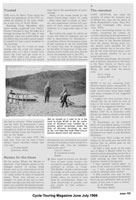 bars and saddle, the rider combats both the high rolling resistance (think riding through centimetres of mud) and wayward road manners of those cute balloon tyres. It cannot be compared to the soft-tyred Raleigh RSW in this respect – the RSW may have a reputation for being slow and ponderous, but trust me, it's a dynamic powerhouse in the company of the Bootie.
bars and saddle, the rider combats both the high rolling resistance (think riding through centimetres of mud) and wayward road manners of those cute balloon tyres. It cannot be compared to the soft-tyred Raleigh RSW in this respect – the RSW may have a reputation for being slow and ponderous, but trust me, it's a dynamic powerhouse in the company of the Bootie.
The gearing is low, as the 14 tooth sprocket and 52 tooth chainwheel don't fully compensate for the tiny wheels (serendipitously, considering the capabilities of the bike) – in fact, it has the lowest gearing of any three speed I've tried. Low gear feels almost like first gear on a derailleur bike, and I can often go straight from first to third; high gear may be approaching second gear of the sporting Raleigh RSW. The gearing makes ascending steep hills a breeze, but the 75 cm wheelbase, high centre of gravity and pothole-seeking wheels make descending them scary.
Bootie variants
Before concluding this article, I should mention a few Bootie variants that didn't make it into production. The first is a tandem, a rather robust-looking affair that could have served duty as a bridge truss. 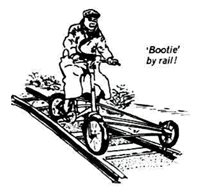 It was demonstrated at the York CTC rally in 1967(?), in one instance by a pair of men making hard work of riding on the grass, and another by a pair of women hardly raising a sweat at all as they manoeuvre for the camera.
It was demonstrated at the York CTC rally in 1967(?), in one instance by a pair of men making hard work of riding on the grass, and another by a pair of women hardly raising a sweat at all as they manoeuvre for the camera.
The other variant was a Bootie-based railway track inspection vehicle. The newsletter (no. 20 Special) of the Railway Velocipede Society in the UK has a copy of an article about a Bootie with an outrigger-mounted third wheel for use on railway tracks. Apparently British Rail asked Kitchins to design a small wheeled bike to run on road or rail for track inspections. With the outrigger folded upwards the bike could be ridden as usual. I think that anyone who has ridden a Bootie – a consuming task at the best of times – would wonder about that. (Thanks to the Velocipede people.)
I hope you have enjoyed reading about the Bootie Folding Cycle, the 60s take on the ultra-compact bike with tuckaway bars and seatpost. In looking at the photos of the blue, second generation bike, you may notice variations in tyres, parts and accessories. This is because the photos were taken as I experimented with different parts as I went along, one of the (yes, arcane) joys of having an old bike. And don't forget, I'm always on the lookout for more information about the Bootie, so I would be grateful for anything you can contribute about this wonderful little machine or the company that made it.

